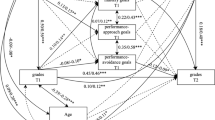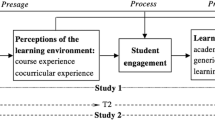Abstract
This longitudinal study (N = 540, grades 7 and 8) was conducted over 2 years (four measurement points) with a perceptual construct questionnaire and access to students’ report cards. The changes in interest, self-concept, and the intention to pursue studies and a career in science and technology were explored as well as the reciprocal causal links between them, while also integrating four exogenous variables: achievement, perceived easiness, gender, and pedagogical novelty. Structural equation modeling was used with the partial least squares (PLS) regression technique. The findings indicate that interest and self-concept do not appear to be mutually dependent and that interest mostly depends on pedagogical novelty, perceived easiness, and the intention to pursue while self-concept depends on achievement and perceived easiness. Easiness was identified as a potentially strong predictor of most constructs about the students’ relationship with the topic and even of the intention to pursue.




Similar content being viewed by others
References
Anderhag, P., Wickman, P.-O., Bergqvist, K., Jakobson, B., Hamza, K. M., & Säljö, R. (2016). Why do secondary school students lose their interest in science? Or does it never emerge? A possible and overlooked explanation. Science Education, 100(5), 791–813. https://doi.org/10.1002/sce.21231.
Bandura, A. (1988). Self-regulation of motivation and action through goal systems. In V. Hamilton, G. H. Bower, & N. H. Frijda (Eds.), Cognitive perspectives on emotion and motivation (Vol. 44). Dordrecht: Springer.
Baram-Tsabari, A., & Yarden, A. (2007). Interest in biology: A developmental shift characterized using self-generated questions. American Biology Teacher, 69(9), 532–540.
Barmby, P., Kind, P. M., & Jones, K. (2008). Examining changing attitudes in secondary school science. International Journal of Science Education, 30(8), 1075–1093.
Boeve-de Pauw, J., Van Hoof, J., & Van Petegem, P. (2018). Effective field trips in nature: The interplay between novelty and learning. Journal of Biological Education, 1–13. https://doi.org/10.1080/00219266.2017.1418760.
Bong, M., Lee, S. K., & Woo, Y.-K. (2015). The roles of interest and self-efficacy in the decision to pursue mathematics and science. In K. A. Renninger, M. Nieswandt, & S. Hidi (Eds.), Interest in mathematics and science learning (pp. 33–48). Washington D.C.: AERA Books.
Cavas, P. (2011). Factors affecting the motivation of Turkish primary students for science learning. Science Education International, 22(1), 31–42.
Chinn, W. W. (1998). The partial least squares approach to structural equation modeling. In G. A. Marcoulides (Ed.), Modern methods for business research (pp. 295–336). Mahwah: Lawrence Earlbaum.
Christidou, V. (2011). Interest, attitudes and images related to science: Combining students’ voices with the voices of school science, teachers, and popular science. International Journal of Environmental and Science Education, 6(2), 141–159.
Ganley, C. M., & Lubienski, S. T. (2016). Mathematics confidence, interest, and performance: Examining gender patterns and reciprocal relations. Learning and Individual Differences, 47(April), 182–194. https://doi.org/10.1016/j.lindif.2016.01.002.
Garon-Carrier, G., Boivin, M., Guay, F., Kovas, Y., Dionne, G., Lemelin, J.-P., et al. (2016). Intrinsic motivation and achievement in mathematics in elementary school: a longitudinal investigation of their association. Child Development, 87(1), 165–175. https://doi.org/10.1111/cdev.12458.
Geertje, L., Patrick, O., & Hilde, C. (2010). Teacher–child interactions: Relations with children's self-concept in second grade. Infant and Child Development, 19(4), 385–405. https://doi.org/10.1002/icd.672.
George, R. (2006). A cross-domain analysis of change in students’ attitudes toward science and attitudes about the utility of science. International Journal of Science Education, 28(6), 571–589.
Gogol, K., Brunner, M., Preckel, F., Goetz, T., & Martin, R. (2016). Developmental dynamics of general and school-subject-specific components of academic self-concept, academic interest and academic anxiety. Frontiers in Psychology, 7(356). https://doi.org/10.3389/fpsyg.2016.00356.
Gottfried, A. E., Marcoulides, G. A., Gottfried, A. W., & Oliver, P. H. (2009). A latent curve model of parental motivational practices and developmental decline in math and science academic intrinsic motivation. Journal of Educational Psychology, 101(3), 729–739.
Guvercin, O., Tekkaya, C., & Sungur, S. (2010). A cross age study of elementary students’ motivation towards science learning. Hacettepe University Journal of Education, 39, 233–243.
Hanewald, R. (2013). Transition between primary and secondary school: Why it is important and how it can be supported. Australian Journal of Teacher Education, 38(1), 62–74 Article 5.
Hango, D. (2013). Les différences entre les sexes dans les programmes de sciences, technologies, génie, mathématiques et sciences informatiques (STGM) à l’université. Retrieved from http://www.statcan.gc.ca/pub/75-006-x/2013001/article/11874-fra.pdf
Hasni, A., & Potvin, P. (2015a). L’intérêt pour les sciences et la technologie à l’école: Résultats d’une enquête auprès d’élèves du primaire et du secondaire au Québec (Interest in science and technology in schools: Results of a survey of elementary and secondary school students in Quebec). Retrieved from: http://www.crijest.org/sites/crijest.org/files/Hasni-Potvin-Rapport-CRIJEST-2015-VF.pdf.
Hasni, A., & Potvin, P. (2015b). Student’s interest in science and technology and its relationships with teaching methods, family context and self-efficacy. International Journal of Environmental and ScienceEducation, 10(3), 337–366. https://doi.org/10.12973/ijese.2015.249a.
Helmke, A., & van Aken, M. A. G. (1995). The causal ordering of academic achievement and self-concept of ability during elementary school: A longitudinal study. Journal of Educational Psychology, 87(4), 624–637. https://doi.org/10.1037/0022-0663.87.4.624.
Hidi, S., & Baird, W. (1986). Interestingness—a neglected variable in discourse processing. Cognitive Science, 10(2), 179–194. https://doi.org/10.1207/s15516709cog1002_3.
Hidi, S., & Renninger, K. A. (2006). The four-phase model of interest development. Educational Psychologist, 41(2), 111–127.
Hong, Z.-R., & Lin, H.-s. (2011). An investigation of students’ personality traits and attitudes toward science. International Journal of Science Education, 33(7), 1001–1028.
Jansen M., Lüdtke O., & Schroeders, U. (2016). Evidence for a positive relation between interest and achievement: Examining between-person and within-person variation in five domains. Contemporary Educational Psychology. 46, 116–127. https://doi.org/10.1016/j.cedpsych.2016.05.004.
Kashdan, T. B., & Silvia, P. J. (2009). Curiosity and interest: The benefits of thriving on novelty and challenge. In C. R. Snyder & M. J. Lopez (Eds.), Oxford handbook of positive psychology (pp. 367–378). New-York: Oxford University Press.
Kirikkaya, E. B. (2011). Grade 4 to 8 primary school students’ attitudes towards science: Science enthusiasm. Educational Research and Reviews, 6(4), 374–382.
Koballa, T. R., & Crawley, F. E. (1985). The influence of attitude on science teaching and learning. School Science and Mathematics, 85(3), 222–232. https://doi.org/10.1111/j.1949-8594.1985.tb09615.x.
Krapp, A., & Prenzel, M. (2011). Research on interest in science: Theories, methods, and Findings. International Journal of Science Education, 33(1), 27–50.
Lacroux, A. (2011). Les avantages et les limites de la méthode “Partial Least Square” (PLS) : une illustration empirique dans le domaine de la GRH. Revue de Gestion des Ressources Humaines, 80(2), 45–64. https://doi.org/10.3917/grhu.080.0045.
Leibham, M. B., Alexander, J. M., & Johnson, K. E. (2013). Science interests in preschool boys and girls: Relation to later self-concept and science achievement. Science Education, 97(4), 574–593. https://doi.org/10.1002/sce.21066.
Lent, R. W., Lopez, F. G., & Bieschke, K. J. (1991). Mathematics self-efficacy: Sources and relation to science-based career choice. Journal of Counseling Psychology, 38(4), 424–430. https://doi.org/10.1037/0022-0167.38.4.424.
Liu, Y., & Hou, S. (2017). Potential reciprocal relatioship between motivation and achievement: a longitudinal study. School Psychology International, 1–18. https://doi.org/10.1177/0143034317710574.
Logan, M., & Skamp, K. (2008). Engaging students in science across the primary secondary interface: listening to the students’ Voice. Research in Science Education (38).
Maltese, A. V., & Tai, R. H. (2010). Eyeballs in the fridge: Sources of early interest in science. International Journal of Science Education, 32(5), 669–685.
Marsh, H. W., Trautwein, U., Lüdtke, O., Köller, O., & Baumert, J. (2005). Academic self-concept, interest, grades, and standardized test scores: Reciprocal effects models of causal ordering. Child Development, 76(2), 397–416. https://doi.org/10.1111/j.1467-8624.2005.00853.x.
McCleary, N., Ramsay, C. R., Francis, J. J., Campbell, M. K., & Allan, J. (2014). Perceived difficulty and appropriateness of decision making by general practitioners: A systematic review of scenario studies. BMC Health Services Research, 14, 621. https://doi.org/10.1186/s12913-014-0621-2.
Murphy, C., Ambusaidi, A., & Beggs, J. (2006). Middle East meets west: Comparing children’s attitudes to school science. International Journal of Science Education, 28(4), 405–422.
Nicholls, J. G. (1984). Achievement motivation: Conceptions of ability, subjective experience, task choice, and performance. Psychological Review, 94(3), 328–346. https://doi.org/10.1037/0033-295X.91.3.328.
Oliver, J. S., & Simpson, R. D. (1988). Influences of attitude toward science, achievement motivation, and science self-concept: A longitudinal study. Science Education, 72(2), 143–155.
Osborne, J., Simon, S., & Collins, S. (2003). Attitudes towards science: A review of the literature and its implications. International Journal of Science Education, 25(9), 1049–1079.
Palmer, D. H. (2009). Situational interest generated Duriong an inquiry skills lesson. Journal of Research in Science Teaching, 46(2), 147–165. https://doi.org/10.1002/tea.20263.
Potvin, P., & Hasni, A. (2014a). Interest, motivation and attitude towards science and technology at K-12 levels: a systematic review of 12 years of educational research. Studies in Science Education, 50(1), 85–129. https://doi.org/10.1080/03057267.2014.881626.
Potvin, P., & Hasni, A. (2014b). Analysis of the decline in interest towards school science and technology from grades 5 through 11. Journal of Science Education and Technology, 23(6), 784–802. https://doi.org/10.1007/s10956-014-9512-x.
Potvin, P., & Hasni, A. (2017a). Encouraging students with different profiles of perceptions to pursue science by choosing appropriate teaching methods for each age group. Research in Science Education. https://doi.org/10.1007/s11165-016-9605-z.
Potvin, P., Hasni, A., & Sy, O. (2017b). Using inquiry-based interventions to improve secondary students’ interest in science and technology. European Journal of Science and Mathematics Education, 5(3), 262–270.
Reid, N., & Skryabina, E. A. (2002). Attitudes towards physics. Research in Science and Technological Education, 20(1), 67–81.
Renninger, K. A., & Hidi, S. E. (2016). The power of interest for motivation and engagement. New-York: Routledge.
Rotgans, J., & Schmidt, H. G. (2017). The relation between individual interest and knowledge acquisition. British Educational Research Journal, 43(2), 350–371. https://doi.org/10.1002/berj.3268.
Siddiqui, N. (2014). Is a summer school programme a promising intervention in preparation for transition from primary to secondary school? International education studies, 7(7), 125–135. https://doi.org/10.5539/ies.v7n7p125.
Simpson, R. D., & Oliver, J. S. (1985). Attitude toward science and achievement motivation profiles of male and female science students in grades six through ten. Science Education, 69(4), 511–525. https://doi.org/10.1002/sce.3730690407.
Simpson, R. D., & Oliver, J. S. (1990). A summary of major influences on attitude toward and achievement in science among adolescent students. Science Education, 74(1), 1–18. https://doi.org/10.1002/sce.3730740102.
Singh, K., Granville, M., & Dika, S. (2002). Mathematics and science achievement: Effects of motivation, interest, and academic engagement. Journal of Educational Research, 95(6), 323–332.
Sorge, C. (2007). What happens? Relationship of age and gender with science attitudes from elementary to middle school. Science Educator, 16(2), 33–37.
Taskinen, P. H., Schütte, K., & Prenzel, M. (2013). Adolescents’ motivation to select an academic science related-career: The role of school factors, individual interest, and science self-concept. Educational Research and Evaluation, 19(8), 717–733. https://doi.org/10.1080/13803611.2013.853620.
Vedder-Weiss, D., & Fortus, D. (2011). Adolescents’ declining motivation to learn science: Inevitable or not? Journal of Research in Science Teaching, 48(2), 199–216.
Venturini, P. (2007). L’envie d’apprendre les sciences (The desire to learn science). Paris: Fabert.
Vygotski, L. (1997). Pensée et langage (Thought and language). Paris: La dispute/Inédit.
Weidinger, A. F., Steinmayr, R., & Spinath, B. (2017). Math grades and intrinsic motivation in elementary school: A longitudinal investigation of their association. British Journal of Educational Psychology, 87(2), 187–204. https://doi.org/10.1111/bjep.12143.
Acknowledgements
Special thanks to the following school boards for their financial and organizational help with this project: Commissions scolaires de Montréal, Rivière-du-Nord, des Hautes-Rivières, des Grandes-Seigneuries, and Marie-Victorin. We would also like to thank David Covino (CSDGS), Bénédicte Boissard (CSRDN), Maria Naciri (CDMV), Jean-François Michaud (CSHR), Geneviève Morin (CSDM), and Daniel Lytwynuk (CSDM) for their help collecting data, and all the teachers who accepted to devote class time to this project. Thank you also to the participants for their honesty and their time, to Yannick Skelling-Desmeules for his insight on data analysis, and to Amine Mahhou for his help with data entry.
Author information
Authors and Affiliations
Corresponding author
Rights and permissions
About this article
Cite this article
Potvin, P., Hasni, A., Sy, O. et al. Two Crucial Years of Science and Technology Schooling: A Longitudinal Study of the Major Influences on and Interactions Between Self-Concept, Interest, and the Intention to Pursue S&T. Res Sci Educ 50, 1739–1761 (2020). https://doi.org/10.1007/s11165-018-9751-6
Published:
Issue Date:
DOI: https://doi.org/10.1007/s11165-018-9751-6




